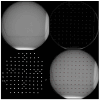Enhancing Single-Plane Fluoroscopy: A Self-Calibrating Bundle Adjustment for Distortion Modeling
- PMID: 38473039
- PMCID: PMC10931011
- DOI: 10.3390/diagnostics14050567
Enhancing Single-Plane Fluoroscopy: A Self-Calibrating Bundle Adjustment for Distortion Modeling
Abstract
Single-plane fluoroscopy systems with image intensifiers remain commonly employed in a clinical setting. The imagery they capture is vulnerable to several types of geometric distortions introduced by the system's components and their assembly as well as interactions with the local and global magnetic fields. In this study, the application of a self-calibrating bundle adjustment is investigated as a method to correct geometric distortions in single-plane fluoroscopic imaging systems. The resulting calibrated imagery is then applied in the quantitative analysis of diaphragmatic motion and potential diagnostic applications to hemidiaphragm paralysis. The calibrated imagery is further explored and discussed in its potential impact on areas of surgical navigation. This work was accomplished through the application of a controlled experiment with three separate Philips Easy Diagnost R/F Systems. A highly redundant (~2500 to 3500 degrees-of-freedom) and geometrically strong network of 18 to 22 images of a low-cost target field was collected. The target field comprised 121 pre-surveyed tantalum beads embedded on a 25.4 mm × 25.4 mm acrylic base plate. The modeling process resulted in the estimation of five to eight distortion coefficients, depending on the system. The addition of these terms resulted in 83-85% improvement in terms of image point precision (model fit) and 85-95% improvement in 3D object reconstruction accuracy after calibration. This study demonstrates significant potential in enhancing the accuracy and reliability of fluoroscopic imaging, thereby improving the overall quality and effectiveness of medical diagnostics and treatments.
Keywords: 3D point reconstruction; geometric distortion correction; quantitative measurement; self-calibration; single-plane fluoroscopy.
Conflict of interest statement
The authors declare no conflicts of interest.
Figures









Similar articles
-
Rigorous geometric self-calibrating bundle adjustment for a dual fluoroscopic imaging system.IEEE Trans Med Imaging. 2015 Feb;34(2):589-98. doi: 10.1109/TMI.2014.2362993. Epub 2014 Oct 14. IEEE Trans Med Imaging. 2015. PMID: 25330483
-
Robust Self-Supervised Learning of Deterministic Errors in Single-Plane (Monoplanar) and Dual-Plane (Biplanar) X-Ray Fluoroscopy.IEEE Trans Med Imaging. 2020 Jun;39(6):2051-2060. doi: 10.1109/TMI.2019.2963446. Epub 2020 Jan 1. IEEE Trans Med Imaging. 2020. PMID: 31902759
-
Correcting geometric image distortions in slice-based 4D-MRI on the MR-linac.Med Phys. 2019 Jul;46(7):3044-3054. doi: 10.1002/mp.13602. Epub 2019 Jun 7. Med Phys. 2019. PMID: 31111494
-
Minimizing magnetic resonance image geometric distortion at 7 Tesla for frameless presurgical planning using skin-adhered fiducials.Med Phys. 2023 Feb;50(2):694-701. doi: 10.1002/mp.16035. Epub 2022 Nov 12. Med Phys. 2023. PMID: 36301228 Review.
-
Aspects of MR image distortions in radiotherapy treatment planning.Strahlenther Onkol. 2001 Feb;177(2):59-73. doi: 10.1007/pl00002385. Strahlenther Onkol. 2001. PMID: 11233837 Review.
References
-
- National Research Council (US) Institute of Medicine (US) Committee on the Mathematics. Physics of Emerging Dynamic Biomedical Imaging . Mathematics and Physics of Emerging Biomedical Imaging. National Academies Press; Washington, DC, USA: 1996. Image-Guided Minimally Invasive Diagnostic and Therapeutic Interventional Procedures.
Grants and funding
LinkOut - more resources
Full Text Sources

